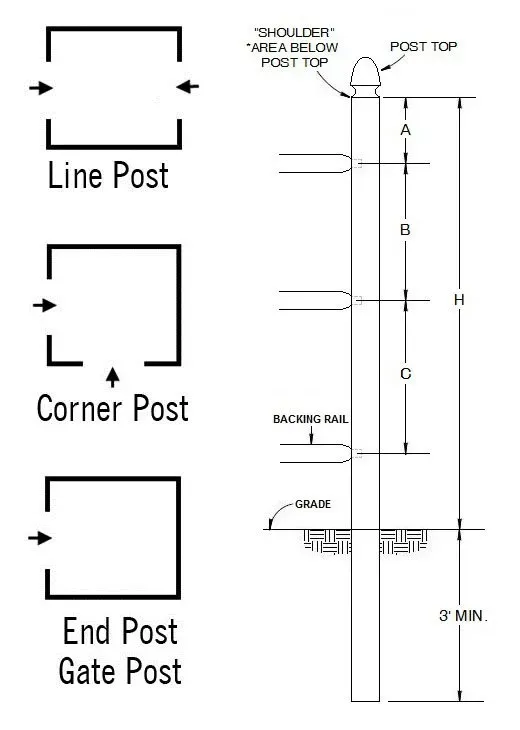- What is the best type of material for a wooden fence?
The best and longest lasting fences are build with Northern White Cedar. - Why is cedar the best?
The heartwood is resistant to decay, making it especially desirable for service in contact with the ground. - How long will it last?
Cedar’s natural resistance will give it a life expectancy of 15-20 years.* A comparable fence made with spruce would have a life expectancy of 3-7 years. - Do the posts need to be treated?
No, tests have proven that dipping a cedar post in creosote will not affect the life expectancy of the post. Posts should go 36″ into the ground. - What type of joint should I use between the post and panel?
Use dowel-end backer rails, which fit into a drilled post. “Nail on” type panels don’t have the strength to last. - Should I use “backer rails”?
Yes, use cedar backer rails; either the rustic round rail, or the molded dowel 2″x3″ rail. - What are the best pickets to use?
#1 cedar pickets are 100% solid wood, solid knots, with no bark. The most commonly used picket is Stockade Picket which measures 2 7/8″x7/8″ and will not shrink as spruce pickets do. - What type of nails should be used?
Use either galvanized steel or aluminum nails. #1 panels should have 5 nails per picket (4 nails on 4′ height). - Should the panels be stained?
They can, but ordinarily a cedar fence is left unfinished to weather bleach naturally to a beautiful silver gray. - What is wood “checking”?
When full round timber dries, the exterior surface (sapwood) shrinks faster than the inner surface (heartwood). The result is the familiar “check” which is technically neither a split nor a crack. View more information about checking.
*Extremely wet or shaded conditions will shorten the life expectancy of the fence. It is not recommended to set Cedar Posts in concrete footings, this will result in shorten lifespan of the post.
Identifying Picket Styles
The styles we carry are Stockade Picket, Cottage Picket, Bishop Picket, Dog-Ear Board, Flat Top Board, Gothic Picket and Victorian Picket (Please See Below).With the exception of the “Bishop” Picket, all styles are available standard in 4′,6′ and 8′ Lengths and can be cut to custom lengths. Stockade Picket is the most common and least expensive style. It measures 7/8” x 2 7/8” and has a slightly pointed top and a rounded face. The Cottage and Bishop Pickets are a 1 x 3 Flat-board style while the Dog-Ear, Flat Top and Gothic Pickets are 1 x 4 Flat-board style. The Victorian Picket is a 2 x 2 Picket with an Apex Top, it is the only picket style that is available in Western Red Cedar, all others are Northern White Cedar.
Post Types

Drilled Posts
We stock all our Cedar Posts as “Blanks”, meaning they do not have holes drilled in them. Our Fencing uses a “Mortise & Tenon” style joint, where a round dowel on the fence section fits into a drilled hole on the post. While we have a set standard for our hole spacing, not all fences are created equally so it is very important to accurately measure your posts hole spacing before purchasing or ordering materials. If you are planning on purchasing a “Drilled” post, please call and order ahead. See below for how to correctly measure your post.

Installing a Fence on a Slop
There are three main ways to install a Cedar Fence on a slope (or grade). They are Stepping, Racking or Straight (please note these methods also apply to Ornamental Aluminum Fence and Vinyl Fence). With Stepping the top of the fence stays level and each section drops down to keep as small of a gap as possible between the bottom of the fence and the ground. When you Rack a fence, the top of the fence sections angle down (or up) to match the pitch of the grade. This is the most common method we use for installing a fence on a grade. Racking the fence allows for very little gap between the bottom of the fence and the ground. When done correctly, the fence can have a nice elegant flow that matches the terrain well. Straight is when you keep the top of the fence consistent and level. This is the least common practice as it results in large gaps under the fence. We typically use this method if a customer is trying to maximize the height of the fence. Please see below for a comparison of the three ways to install a fence on a slope.







